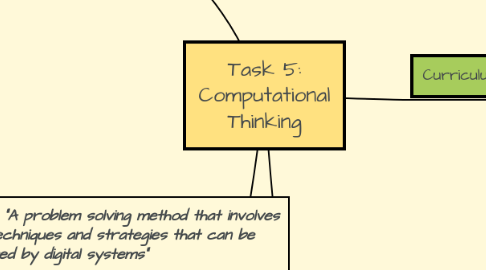
1. Types of Computational Thinking
1.1. Decomposition
1.1.1. breaking down data, processes or problems into smaller manageable parts
1.2. Pattern Recognition
1.2.1. observing pattern trends and regularities in data
1.3. Abstraction
1.3.1. identifying general principles that generate these patterns
1.4. Algorithm Design
1.4.1. developing the step by step instructions for solving this and similar problems
2. Definition: "A problem solving method that involves various techniques and strategies that can be implemented by digital systems"
2.1. Involves
2.1.1. Problem Solving
2.1.2. Communication
2.1.3. Collaboration
2.1.4. Creativity
2.1.5. Critical Thinking
2.1.6. Computing
2.2. Techniques
2.2.1. Organising data logically
2.2.2. breaking down problems into parts
2.2.3. defining abstract concepts
2.2.4. designing and using algorithms, patterns and models
3. Resources
3.1. CoderDojo
3.2. Scratch
3.3. Code.org
4. 2018 = mandatory for students from pre-primary to year 8 in WA schools to learn technologies.
4.1. Meaning teachers need to plan, teach, assess and monitor back to parents/caregivers
4.2. Most schools will be timetabling 1 hour per week
5. The goal is to use computational thinking as a way that "integrates the power of human thinking with the capability of computers"
6. Cross Curricular Opportunities
6.1. English
6.1.1. Analyse a poem - structure, tone, meaning
6.2. HASS
6.2.1. How weather seasons vary around the world
6.3. Food Tech
6.3.1. Research and type a recipe for others to use
6.4. Maths
6.4.1. Create an algorithm to count quickly using repeated addition
6.5. Science
6.5.1. Determine rules for chemical bondings and interactions
6.6. HPE
6.6.1. How to successfully throw a javelin
6.7. Languages
6.7.1. Solving problems, decoding language systems
7. Curriculum Links
7.1. Year F - 2
7.1.1. Follow describe and represent a sequence of steps and decisions (algorithms) needed to solve simple problems (ACTDIP004)
7.2. Year 3 - 4
7.2.1. Define Simple problems and describe and follow a sequence of steps and decisions (algorithms) needed to solve them (ACTDIP010)
7.2.2. Implement simple digital solutions as visual programs with algorithms involving branching (decisions) and user input (ACTDIP011)
7.3. Year 5 - 6
7.3.1. Design a user interface for a digital system (ACTDIP018)
7.3.2. Design, modify and follow simple algorithms involving sequences of steps, branching and iteration (repetition) (ACTDIP019)
7.3.3. Implement digital solutions as simple visual programs involving branching iteration (repetition) and user input (ACTDIP020)
